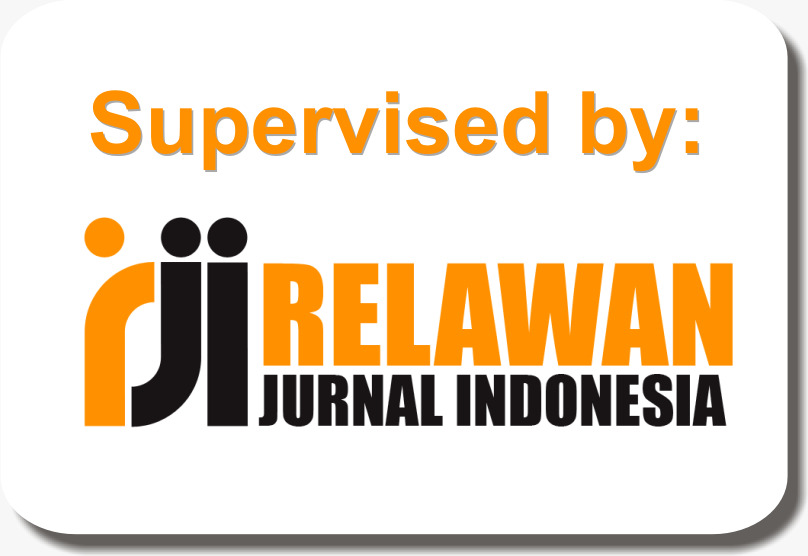PEMODELAN DATA RADIOSONDE MENGGUNAKAN STACKING ENSEMBLE UNTUK KLASIFIKASI HUJAN
Abstract
Keywords
Full Text:
PDFArticle Metrics :
References
I. Iskandar et al., Weather and Climate Extreme Events in a Changing Climate. IPCC_AR6_WGI_Chapter11, 2021. doi: 10.1017/9781009157896.013.1514.
D. D. Putra, B. F. Sofwany, H. Zulfinanda, and I. Kamaruddin, “Flash flood (Δ) risk and damage assessment in batu, East Java,” J. Teknosains, vol. 12, no. 1, p. 72, 2022, doi: 10.22146/teknosains.78483.
Z. Song, W. Bai, Y. Zhang, Y. Wang, X. Xu, and J. Xin, “Evaluation of Satellite-Derived Atmospheric Temperature and Humidity Profiles and Their Application as Precursors to Severe Convective Precipitation,” Remote Sens., vol. 16, no. 24, 2024, doi: 10.3390/rs16244638.
F. M. Mashao et al., “An Appraisal of the Progress in Utilizing Radiosondes and Satellites for Monitoring Upper Air Temperature Profiles,” pp. 1–31, 2024.
B. Bochenek and Z. Ustrnul, “Machine Learning in Weather Prediction and Climate Analyses—Applications and Perspectives,” Atmosphere (Basel)., vol. 13, no. 2, pp. 1–16, 2022, doi: 10.3390/atmos13020180.
W. Han et al., “Targeted sounding observations from geostationary satellite and impacts on high impact weather forecasts,” Sci. China Earth Sci., vol. 68, no. 4, pp. 963–976, 2025, doi: 10.1007/s11430-024-1489-5.
M. Putra, M. S. Rosid, and D. Handoko, “A Review of Rainfall Estimation in Indonesia: Data Sources, Techniques, and Methods,” Signals, vol. 5, no. 3, pp. 542–561, 2024, doi: 10.3390/signals5030030.
H. Zhang, Y. Liu, C. Zhang, and N. Li, “Machine Learning Methods for Weather Forecasting: A Survey,” Atmosphere (Basel)., vol. 16, no. 1, pp. 1–34, 2025, doi: 10.3390/atmos16010082.
X. Gao et al., “A Comprehensive Survey on Imbalanced Data Learning,” pp. 1–27, 2025, [Online]. Available: http://arxiv.org/abs/2502.08960
O. S. Riza and A. Nuryadi, “Bibliometric Study : Rainfall Classification - Prediction using Machine Learning Methods,” Digit. Zo. J. Teknol. Inf. dan Komun., vol. 14, no. 2, pp. 206–218, 2023, doi: 10.31849/digitalzone.v14i2.16618.
S. I. Rani, P. Sharma, J. P. George, and M. Das Gupta, “Assimilation of individual components of radiosonde winds: An investigation to assess the impact of single-component winds from space-borne measurements on NWP,” J. Earth Syst. Sci., vol. 130, no. 2, 2021, doi: 10.1007/s12040-021-01604-3.
J. Gu, S. Liu, Z. Zhou, S. R. Chalov, and Q. Zhuang, “A Stacking Ensemble Learning Model for Monthly Rainfall Prediction in the Taihu Basin, China,” Water (Switzerland), vol. 14, no. 3, pp. 1–20, 2022, doi: 10.3390/w14030492.
P. I. Khan et al., “Observed Climatology and Trend in Relative Humidity, CAPE, and CIN over India,” Atmosphere (Basel)., vol. 13, no. 2, pp. 1–13, 2022, doi: 10.3390/atmos13020361.
L. N. Zhang, D. J. S. Gianotti, and D. Entekhabi, “Land Surface Influence on Convective Available Potential Energy (CAPE) Change during Interstorms,” J. Hydrometeorol., vol. 24, no. 8, pp. 1365–1376, 2023, doi: 10.1175/JHM-D-22-0191.1.
B. Golding, Towards the “Perfect” Weather Warning: Bridging Disciplinary Gaps through Partnership and Communication. 2022.
W. F. P. Qatrinnada, E. Hidayah, G. Halik, and R. U. A. Wiyono, “A literature review: rainfall thresholds as flash flood monitoring for an early warning system,” Water Pract. Technol., vol. 19, no. 11, pp. 4486–4498, 2024, doi: 10.2166/wpt.2024.271.
P. Frederick, J. C. Finley, and C. Magalis, “A Quantitative Analysis for Non-Numeric Data,” Int. J. Quant. Qual. Res. Methods, vol. 11, no. 1, pp. 1–11, 2023, doi: 10.37745/ijqqrm13/vol11n1111.
A. Deji, C. Steve, and D. John, “A Systematic Literature Review on Data Cleaning Techniques and Their Impact on Machine Learning,” no. December 2023, 2025.
A. P. Joshi and B. V. Patel, “Data Preprocessing: The Techniques for Preparing Clean and Quality Data for Data Analytics Process,” Orient. J. Comput. Sci. Technol., vol. 13, no. 0203, pp. 78–81, 2021, doi: 10.13005/ojcst13.0203.03.
I. Gustari, T. W. Hadi, S. Hadi, and F. Renggono, “Akurasi Prediksi Curah Hujan Harian Operasional Di Jabodetabek : Perbandingan Dengan Model Wrf,” J. Meteorol. dan Geofis., vol. 13, no. 2, pp. 119–130, 2012, doi: 10.31172/jmg.v13i2.126.
C. Andrade, “Z Scores, Standard Scores, and Composite Test Scores Explained,” Indian J. Psychol. Med., vol. 43, no. 6, pp. 555–557, 2021, doi: 10.1177/02537176211046525.
A. S. Hussein, T. Li, C. W. Yohannese, and K. Bashir, “A-SMOTE: A new preprocessing approach for highly imbalanced datasets by improving SMOTE,” Int. J. Comput. Intell. Syst., vol. 12, no. 2, pp. 1412–1422, 2019, doi: 10.2991/ijcis.d.191114.002.
S. Aymaz, Unlocking the power of optimized data balancing ratios: a new frontier in tackling imbalanced datasets, vol. 81, no. 2. Springer US, 2025. doi: 10.1007/s11227-025-06919-2.
R. Natras, B. Soja, and M. Schmidt, “Ensemble Machine Learning of Random Forest, AdaBoost and XGBoost for Vertical Total Electron Content Forecasting,” Remote Sens., vol. 14, no. 15, pp. 1–34, 2022, doi: 10.3390/rs14153547.
Aditya Gumilar, Sri Suryani Prasetiyowati, and Yuliant Sibaroni, “Performance Analysis of Hybrid Machine Learning Methods on Imbalanced Data (Rainfall Classification),” J. RESTI (Rekayasa Sist. dan Teknol. Informasi), vol. 6, no. 3, pp. 481–490, 2022, doi: 10.29207/resti.v6i3.4142.
A. de la Cruz Huayanay, J. L. Bazán, and C. M. Russo, “Performance of evaluation metrics for classification in imbalanced data,” Comput. Stat., vol. 40, no. 3, pp. 1447–1473, 2024, doi: 10.1007/s00180-024-01539-5.
L. Mdegela, E. Municio, Y. De Bock, E. Luhanga, J. Leo, and E. Mannens, “Extreme Rainfall Event Classification Using Machine Learning for Kikuletwa River Floods,” Water (Switzerland), vol. 15, no. 6, pp. 1–14, 2023, doi: 10.3390/w15061021.
J. Cook, “When to consult precision-recall curves,” no. 1, pp. 131–148, 2020, doi: 10.1177/1536867X20909693.
Z. Erenel, “Improving the precision-recall trade-off in undersampling-based binary text categorization using unanimity rule,” vol. 22, 2013, doi: 10.1007/s00521-012-1056-5.
F. Ahmed, Á. F. Adames, and J. D. Neelin, “Deep convective adjustment of temperature and moisture,” J. Atmos. Sci., vol. 77, no. 6, pp. 2163–2186, 2020, doi: 10.1175/JAS-D-19-0227.1.
J. Pilewskie, G. Stephens, H. Takahashi, and T. L’Ecuyer, “A Multi-satellite Perspective on ‘Hot Tower’ Characteristics in the Equatorial Trough Zone,” Surv. Geophys., vol. 45, no. 6, pp. 1933–1958, 2024, doi: 10.1007/s10712-024-09868-2.
A. R. I. Pratama, S. A. Latipah, and B. N. Sari, “Optimasi Klasifikasi Curah Hujan Menggunakan Support Vector Machine (Svm) Dan Recursive Feature Elimination (Rfe),” JIPI (Jurnal Ilm. Penelit. dan Pembelajaran Inform., vol. 7, no. 2, pp. 314–324, 2022, doi: 10.29100/jipi.v7i2.2675.




